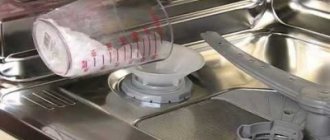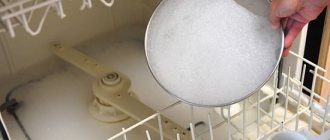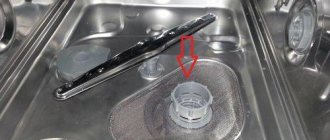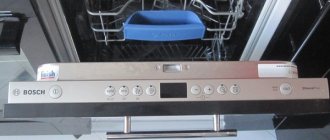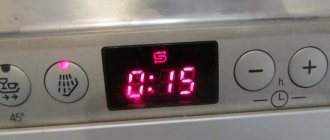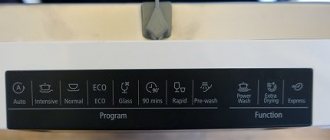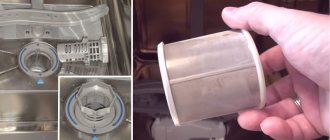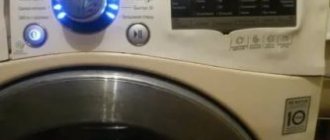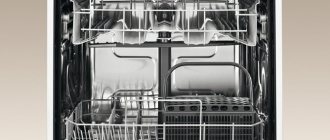Why is the salt light on in my dishwasher? How does it work and what does it say? In this article we will look at all the reasons, possible breakdowns and tell you what to do.
The manufacturer installed indicators on the control panel to make using the dishwasher easy. With their help, you can monitor at what stage of the wash, whether there is enough detergent and rinse aid in the car. All symbols are collected in the instructions; we will only focus on the salt symbol.
Lights up or flashes
The first and main rule: if something in the display of the dishwasher panel alarms you, look at the instructions: it is quite possible that this means one of the normal operating modes of the machine.
If some indicator lights up constantly on the panel, this is most likely normal and means an indication of the current state: for example, the brush icon lights up when the wash starts, and goes out after it finishes. It’s another matter when something starts flashing and the washing mode is disrupted: this may mean a breakdown of some PMM unit. But in any case, these are only general considerations - for a precise description of the behavior of the indicators, you need to look at the instructions.
First, check if the child lock mode is turned on, which blocks all buttons except turning off the machine. A failure of the control module can also cause the button to blink: try resetting the washing program by unplugging the machine for 5-10 minutes.
If this does not help, it means that something in the SMPMMA is broken: most likely the control board, but problems with the door, heater, motor, programmer, or sensors can also lead to a similar effect. Only an experienced technician with the necessary diagnostic equipment can accurately determine the cause.
What is the operating principle of a dishwasher?
What is a dishwasher, its design and operating principle? To understand this issue, you first need to learn about the components of the dishwasher, then you should understand how each unit works, and what role its work plays in the whole system, and only then can you imagine how the dishwasher works.
The internal structure of the dishwasher consists of:
- The hose through which water flows into the machine.
- Controller for water supply to the machine.
- Water supply solenoid valve.
- Electromagnet.
- Air drainage.
- Capacitor.
- Salt exchanger (exchanger).
- Salt reservoir.
- Water pressure sensor and switch.
- Water level sensor with tube.
- Circulation pump.
- A heating element.
- Drainage pump
- Check valve (drainage system).
- Dirty water drainage hose.
This is how the water in the dishwasher heats up.
Why do you need a magnet?
If almost all the elements are intuitive, then we will explain why an electric magnet is needed in a car. This is a directional magnet. It turns on only when water enters the dishwasher from the water supply.
Magnetic induction can affect chemical impurities in water, and the water becomes softer. This improves both the quality of dishwashing and allows you to preserve the internal elements of the machine. In particular, much less scale and other deposits form on the internal elements and heating elements if the water is pre-magnetized.
Why do we need salt and a salt exchanger (exchanger)
Special dishwasher salt is not your regular table salt. It is prohibited to put tableware into the dishwasher. Special salt also improves the cleaning properties of water, helps destroy dirt, and prevents the formation of biological deposits inside the dishwasher. Salt also kills bacteria that may be on the dishes.
Since salt does not enter the dishwasher tank in pure powder form, but in the form of a solution, this solution must first be prepared.
In the salt tank, water mixes with salt and dissolves it. The result is a highly enriched salt solution. Such a solution should not enter the tank, and therefore it ends up in the exchanger. There it is mixed with a large portion of water, reaches an acceptable concentration and is sent to the tank. This completes the work of the exchanger.
What is a salt exchanger (exchanger)
It is called an exchanger or an exchanger. This is a small reservoir, found in more expensive cars. It goes right after the dishwasher salt container at the bottom of the machine. In cheap machines, the salt is exchanged in the reservoir itself. In expensive machines, this small container mixes the fortified saline solution with water to the extent needed. The control unit measures the hardness of the water and determines what concentration the solution should be.
Cheap machines do not have it and the salt is stored and mixed in one place. Naturally, there is no monitoring of concentration.
What is a check valve for?
Everything is simple here. Since the valve operates in the drainage system and essentially completes the process of pumping waste water into the sewer system, it is designed to prevent the flow of dirty water back into the machine. When the drain pump is operating, the valve allows water to flow into the sewer system, but not back.
What are the main programs for dishwashers?
Many users are interested not only in information about how exactly the dishwasher works, but how it works with a particular program. People need this in order to determine which dishes to wash and in what mode. Most users immediately ask the question about the shortest and longest washing programs. And also about the differences between these programs.
One thing can be said about this. All wash cycles are approximately the same. The amount of time calculated for washing and the use of a particular amount of detergent depends on different programs. The wash time is also affected by the set wash temperature. The fact is that it also takes time to heat water, and it also takes time to maintain temperature. The higher the set temperature, the longer the entire washing process will be.
The main phases of washing dishes are the same in all modes. All modes include an active washing phase with detergent and salt, rinsing with clean tap water and drying. In some machines, the drying can be turned off manually when the service manufacturer recommends wiping the dishes with a napkin or drying them on a napkin.
The average duration of the program is:
- At 30 – 45° C the time will take 90 minutes.
- At 45 – 65° C the time will take 160 minutes.
- At 65 - 80° C the time will take 130 minutes.
- Quick wash mode no more than 45 minutes.
- Additional pre-rinse for 10 to 15 minutes
Average values are given. They may vary slightly depending on the manufacturer of the dishwasher. But they will be approximately the same as indicated.
If the manufacturer adds additional phases to the washing program, the time may increase. There is no tendency to reduce washing time, since a method for improving the quality and intensity of washing that would reduce the operating time of the program has not yet been invented.
For heavily dirty dishes, only the longest washing mode at a temperature of at least 60°C is suitable. Hot water will quickly dissolve dirt and enhance the effect of the detergent. Failure to comply with the requirements for choosing a washing mode may result in incompletely washed dishes at the exit. You will have to start the washing program again or wash the dishes manually.
Regardless of the manufacturer and class of the dishwasher, it will always have at least three main washing programs:
- Rinsing dishes. Fastest mode.
- Economical washing. Medium mode for lightly soiled “fresh” dishes.
- Intensive washing. For very dirty dishes, possibly with dried stains.
All dishwashers support the ability to reload dirty dishes. To do this, you do not need to cancel the washing program at all. Simply open the door and the machine will pause itself. After closing the door, washing will continue automatically. Contrary to the myths that if you open the car while working, you will break it, you can open the door.
How a dishwasher works - the master answers
A dishwasher, like other types of household appliances, is designed to help people in everyday life. It's no secret that washing dishes takes a lot of time, and after this process you also need to do cleaning, since there are remnants of detergent and small particles of food everywhere.
Household appliances can reduce a person's time in the kitchen, and this time can be spent on more pleasant and useful things. In order for your dishwasher to last for a long time, you need to know how to use it correctly. And in order to use it correctly, you must first know what the dishwasher does. This is what we will do now.
Possible problems
It happens that you have just filled the ion exchanger, but the indicator on the panel is still on. What to do?
- Try rebooting the machine. To do this, unplug it, then turn it back on.
- After a reboot, the operation of the equipment should be restored.
If this does not happen, mechanical cleaning will help:
- Disconnect the PMM from the network.
- Using a construction vacuum cleaner, pump out the contents of the tank (salt and water).
- You can use a rubber bulb. Pre-mix the contents and pump out.
- Pour in a full section of water.
- Fill the crystals to the top.
- Remove excess moisture from the pan.
- Turn on the dishwasher.
This is usually enough for the light to stop glowing. But if nothing has changed, you need to check the salt sensor.
- Remove the side panel of the machine by unscrewing the mounting screws.
- Remove the heat exchanger (if equipped). Behind it is a sensor.
- The sensor can be easily removed by unscrewing the fasteners and unfastening the wiring.
- Disassemble it and clean it from plaque and dirt.
- Start the equipment again.
- Is the indicator on? Then you will have to install a new sensor.
The problem is that buying a part is not so easy. Usually it is supplied only to workshops. But you can send a request to the manufacturer or contact your nearest workshop.
You can operate the PMM with a non-working sensor, but then the indicator will not work. You will have to determine the salt level manually.
You can find the explanation of each icon and indicator in the instructions. Do not ignore the “messages” of the dishwasher, otherwise the problem may result in a serious repair.
Source
What happens inside the dishwasher when it starts up?
How does a dishwasher work? The operating principle of all dishwashers is slightly different, depending on the brand and manufacturer. But at its core it is identical for everyone.
Washing programs are contained in the dishwasher's EPROM. And the system receives data from a large number of different sensors. The main sensors are: temperature sensor, water level sensor, pressure sensor. Without these three sensors, the machine cannot operate.
Different dishwashers of different classes may have different additional sensors.
Dishwasher control unit.
After loading the dishes and adding detergent, the user turns on the desired program and starts the machine. The control unit determines the required program parameters, set temperature, and duration. Receives data from sensors and determines further actions. Then the fill valve opens.
As soon as the water temperature reaches the desired level, detergent is supplied. At the same time, the control unit also checks the water pressure in the system. If the pressure is not enough for high-quality washing, an error code will appear on the display.
A special pump is responsible for recirculating water in the dishwasher. It is this that creates the necessary pressure inside the water channels of the dishwasher. It determines the intensity with which the water jets will hit the dishes. The quality of operation of the dishwasher depends on its serviceability.
What are the blades for in a dishwasher?
Everyone has seen components in the dishwasher tank that look like fan blades. They are present in every car and perform a very important function. They are similar to blades not only in shape, but also in action. They rotate.
Dishwasher care
To keep your dishwasher in perfect condition, you need to follow a few simple rules:
- Always open the washer door at the end of the wash cycle. This simple action will allow the steam to escape without allowing it to condense on the dishes and walls of the device.
- After each cycle, wipe the interior surfaces of the washing chamber with a dry soft cloth.
- Periodically check and clean the filters of the drain system of the device. The procedure is not complicated, but it effectively protects your home from unpleasant odors.
- If possible, use a wash chamber freshener. By itself, it is inexpensive, but the effect of its use lasts about six months.
- At least once every six months you need to use a comprehensive dishwasher cleaning product. It effectively cleans the drain pipes of the device from fatty deposits, improving the drainage and “microflora” of the hidden cavities of the dishwasher.
Even if you meet face-to-face with an unfamiliar model of dishwasher, you should not panic. Observation, intuition and the acquired knowledge will allow you to deal with it in the best possible way, ultimately getting clean dishes at the end. But it’s still better to download the instructions!
What does the display look like in different brands of dishwashers?
The salt indicator may look different in different dishwashers. In most cases, the indicator is an unsigned asterisk. This designation is typical for Asko .
If we are talking about German dishwashers ( Bosh , Siemens, Hansa, etc.), then the asterisk indicates the rinse aid level, and the indicator consists of 2 curved arrows, symbolizing constant movement.
salt indicator
Indesit dishwashers . In them, the salt indicator is not labeled and is made in the form of an ordinary small light bulb on the left side of the device panel.
Description of technologies
We will tell you about the newest and most interesting developments of Electrolux:
- Glass Care. Mode for delicate care of dishes made of porcelain, glass and other delicate work. The devices are processed at a temperature of 60 degrees, which eliminates the possibility of damage.
- AquaControl. Leakage protection program. Guarantee of complete safety: in the event of a malfunction or leak, the machine is disconnected from electricity and cuts off the water supply.
- AirDry. After finishing the wash, the dishwasher automatically opens the door for natural ventilation of the dishes.
- TimeBeam. This is not just a beam on the floor, but a projection of the exact time until the end of the PMM operation.
Marking on dishes
There is a wide variety of utensils in a modern kitchen. And you will see everything here: ceramic and Teflon frying pans, silicone molds of bizarre configurations, glass and metal, transparent and black. And, if everything is clear with a cast-iron frying pan or an enamel saucepan, familiar from childhood, then questions often arise with another one. Will this cap be useful for baking a pie or something else?
In addition to the traditional burner, today we cook food in the oven, microwave, and convection oven. And the burners have now become different. So the question arises: is it possible to use the same saucepan or cup everywhere? Which one can you pour boiling water into, and which one only takes cold water? What is useful for cooking, and what is only for heating?
You don't have to go far to find answers to these questions. This is precisely why cookware labels exist. In addition to the well-known fork with a glass, which means that a particular product belongs to a food container, there are many others. Have a table like this and, if necessary, just find the icon you need.
